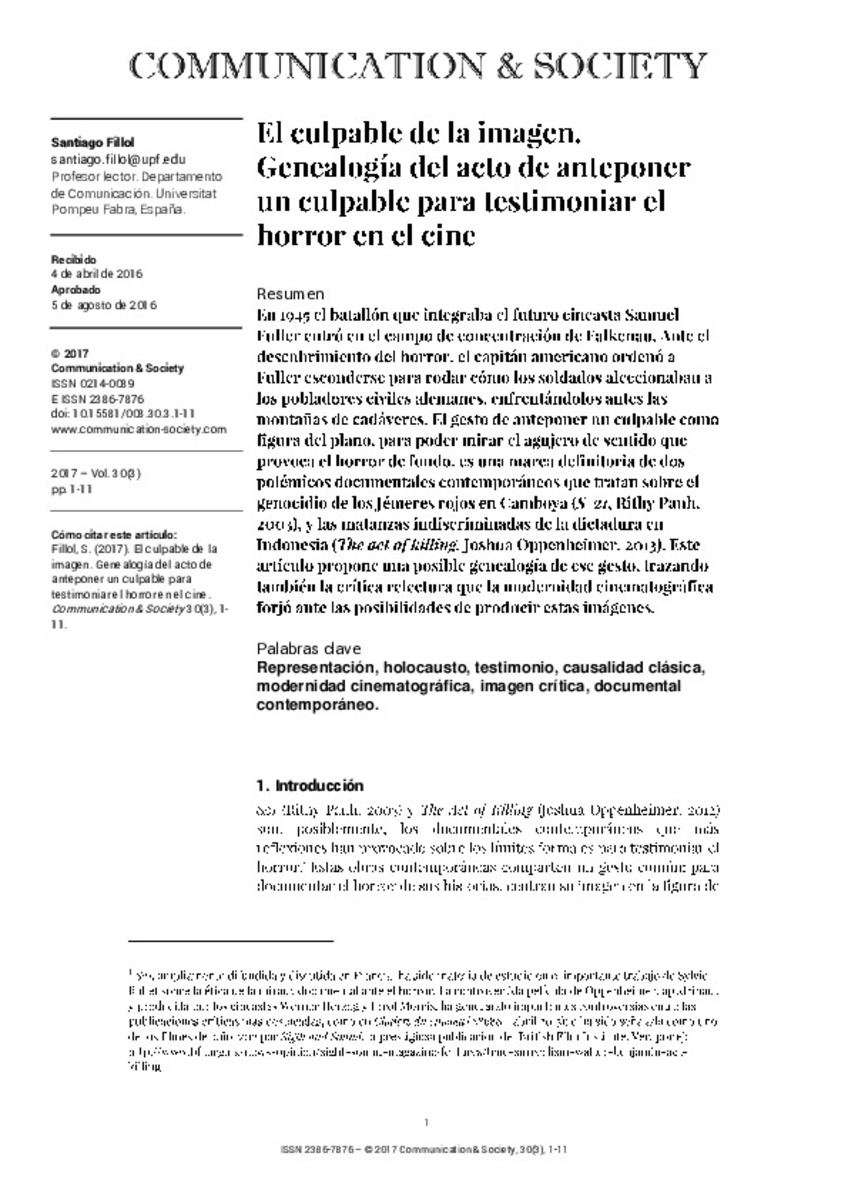Full metadata record
| DC Field | Value | Language |
|---|---|---|
| dc.creator | Fillol, S. (Santiago) | - |
| dc.date.accessioned | 2017-09-26T10:03:11Z | - |
| dc.date.available | 2017-09-26T10:03:11Z | - |
| dc.date.issued | 2017 | - |
| dc.identifier.citation | Fillol, S. (Santiago). "El culpable de la imagen. Genealogía del acto de anteponer un culpable para testimoniar el horror en el cine". Communication & Society. 30 (3), 2017, 1 - 11 | es |
| dc.identifier.issn | 2386-7876 | - |
| dc.identifier.uri | https://hdl.handle.net/10171/43924 | - |
| dc.description.abstract | En 1945 el batallón que integraba el futuro cineasta Samuel Fuller entró en el campo de concentración de Falkenau. Ante el descubrimiento del horror, el capitán americano ordenó a Fuller esconderse para rodar cómo los soldados aleccionaban a los pobladores civiles alemanes, enfrentándolos antes las montañas de cadáveres. El gesto de anteponer un culpable como figura del plano, para poder mirar el agujero de sentido que provoca el horror de fondo, es una marca definitoria de dos polémicos documentales contemporáneos que tratan sobre el genocidio de los Jémeres rojos en Camboya (S-21, Rithy Panh, 2003), y las matanzas indiscriminadas de la dictadura en Indonesia (The act of killing, Joshua Oppenheimer, 2013). Este artículo propone una posible genealogía de ese gesto, trazando también la crítica relectura que la modernidad cinematográfica forjó ante las posibilidades de producir estas imágenes. | es_ES |
| dc.description.abstract | In 1945 the battalion where the future filmmaker Samuel Fuller was serving entered the concentration camp at Falkenau. Upon discovering the horror, the American captain ordered Fuller to hide in order to film how the soldiers taught German civilian villagers a lesson by forcing them to face the piles of corpses. The gesture of placing a culprit in the foreground in order to be able to look at the void of meaning caused by the horror in the background is a defining mark of two controversial contemporary documentaries that deal with the genocide of the Khmer Rouge in Cambodia (S-21, Rithy Panh, 2003), and the mass killings of the dictatorship in Indonesia (The Act of Killing, Joshua Oppenheimer, 2013). This article suggests a possible genealogy of the gesture, also showing the critical rereading developed by modern cinema regarding the possibility of producing such images. | es_ES |
| dc.language.iso | spa | es_ES |
| dc.publisher | Servicio de Publicaciones de la Universidad de Navarra | es_ES |
| dc.rights | info:eu-repo/semantics/openAccess | es_ES |
| dc.subject | Representación | es_ES |
| dc.subject | holocausto | es_ES |
| dc.subject | testimonio | es_ES |
| dc.subject | causalidad clásica | es_ES |
| dc.subject | modernidad cinematográfica | es_ES |
| dc.subject | imagen crítica | es_ES |
| dc.subject | documental contemporáneo | es_ES |
| dc.title | El culpable de la imagen. Genealogía del acto de anteponer un culpable para testimoniar el horror en el cine | es_ES |
| dc.title.alternative | The Culprit of the Image. Genealogy of the act of putting forth a culprit to witness the horror in cinema | es_ES |
| dc.type | info:eu-repo/semantics/article | es_ES |
| dc.identifier.doi | 10.15581/003.30.35765 | es_ES |
| dadun.citation.endingPage | 11 | es_ES |
| dadun.citation.number | 3 | es_ES |
| dadun.citation.publicationName | Communication & Society | es_ES |
| dadun.citation.startingPage | 1 | es_ES |
| dadun.citation.volume | 30 | es_ES |
Files in This Item:
Statistics and impact
Items in Dadun are protected by copyright, with all rights reserved, unless otherwise indicated.






